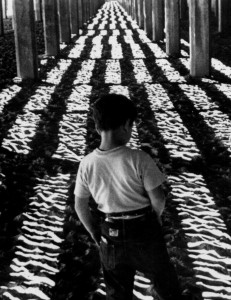At first glance, Little Fugitive (1953) doesn’t look like much. It’s the story of a couple of latchkey kids in 1950s New York: Lenny and his 7-year-old kid brother Joey. When their mother needs to visit a sick relative overnight, Lenny is left in charge. But he’s really too young to take on this kind of responsibility, and instead of watching out for Joey he and his buddies play a cruel prank on him. Using an old rifle and a daub of ketchup they convince Joey that he’s shot and killed his own brother. Terrified, Joey runs away, wandering alone amidst the crowds on Coney Island. Meanwhile, an increasingly frantic Lenny tries to find him.
Stories don’t get much simpler than that, and yet this small indie film — rarely seen today — was enormously influential. Behind the modest plot and the gee-whiz dialogue, a cinematic revolution was taking place. Shot with a small 35mm rig, the movie utilized a cinema-verite style that helped inspire the French New Wave movement; Truffaut in particular was enamored with the film. As an added bonus, its crisp, neo-realist look brings to life the lost world of New York in the 1950s.
Little Fugitive also shows a rough edge to American life seldom seen in films of this era; the unsupervised kids amuse themselves on the city streets while their worn-down single mom struggles to provide for them. When she is called away by a medical emergency, she has no choice but to leave the kids alone overnight. Cinema of the 1950s often presented a New York that was glamorous, or dangerous, or even seedy. But rarely has the city seemed as imposing and immediate as it does in this modest production. — Michael Popham
LITTLE FUGITIVE screens Friday and Saturday, April 17 and 18, at 7:00 and 9:00, and Sunday, April 19 at 5:00 and 7:00 at the Trylon. Advance tickets are $8.00, and you can purchase them here.

